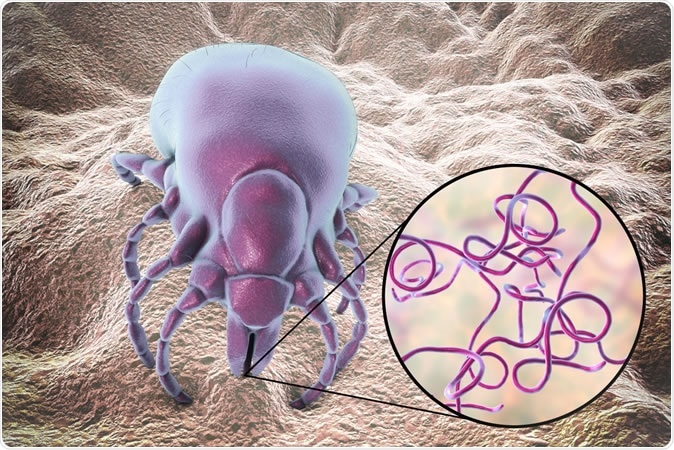The tick-borne disease called Lyme disease is caused by a bacterium that produces both acute and chronic symptoms and signs. Ticks are usually picked up while walking through infested areas. The disease initially manifests as a bull’s-eye or target rash, which is characteristic of the disease. However, this is not universally present in all individuals with Lyme disease. Thus about 10% to 20% of these patients are likely to be diagnosed much later when they come down with delayed manifestations such as arthritis or palpitations. This makes it necessary to find a way to diagnose it more sensitively and earlier in its course.
Every year, about 300,000 Americans come down with Lyme disease, caused by the bacterium Borrelia burgdorferi, making it the most common infectious disease caused by any vector-borne agent. Black-legged ticks of the Ixodes genus are responsible for carrying this bacterium.

Lyme disease bacteria, Borrelia burgdorferi, transmitted by Ixodes tick, 3D illustration. Image Credit: Kateryna Kon / Shutterstock
The first symptoms occur within 30 days, and include the rash, fever, chills, headache and muscle pains. Prompt antibiotic treatment can arrest the course of the disease. If untreated, the disease progresses to nerve palsy, especially of the facial nerve, neurological pain, joint pain and swelling, and palpitations due to heart block. This is seen in up to a fifth of all patients.
Diagnosis of Lyme disease
While the disease can be diagnosed directly by detecting the nucleic acid of the organism, or by culturing the bacterium, these are time-consuming and not as sensitive as could be desired. The issue is that the bacterium is present for only a short time and in low concentrations in the blood, making direct detection of the bacterium a challenge.
Indirect detection by blood tests that detect specific antibodies to the bacterium is also disappointing, especially in the early stages, when it is most necessary to diagnose it in order to start appropriate treatment.
Currently, a two-tier testing procedure is the diagnostic standard: first a sensitive enzyme immunoassay or immunofluorescence assay, followed by a Western blot for confirmation by picking up specific antibodies. However, this is sensitive and specific only with late Lyme disease, though treatment is most effective and cheapest in early disease. Besides, most patients are seen with early disease. Thirdly, the set up for this type of testing is expensive, requires upscale infrastructure, and trained technicians, making it non-feasible for the very populations where the tick bites are most likely to happen.
The study
The current study was motivated by the need to come up with a rapid, convenient and cheap diagnostic test that would show the presence of the infection early in the disease course. They used existing knowledge about paper-based assays and deep machine learning to come up with a new, cheap and fast test for early-stage Lyme disease.
The researchers designed a small device that is meant to find the presence of the bacterium in blood samples. It uses a stack of functionalized papers as the basic material and a sensing membrane. The paper stack is functionalized with seven bacterial antigens as well as an artificial peptide, localized in 13 spots. The device is exposed to the serum which flows vertically through the stacks, so that the antibodies to the bacteria can bind to the spots. The bound antibodies are then treated with a color-changing solution that will show how much bound antibody is present.
The colored spots are photographed using a customized smart phone-based reader. The analysis of the color changes is then carried out based on a neural network developed for this study, which is capable of deep learning to determine if the sample is negative for the disease or positive. This is based on the presence of antibody binding to an optimal antigen/peptide target subset selected by the deep learning algorithm.
The device was tested on 50 samples, some of which were positive and some negative for the early stages of Lyme disease.
The findings
The results showed that it was over 96% specific and picked up almost 86% of positive samples. This is much higher than that of existing tests, which is below 50%. Moreover, the test is completed in about 15 minutes rather than the more than 24 hours of existing two-tier testing. It also comes at an incredibly low cost of only 42 cents compared to the above $400 cost of conventional serologic testing.
Implications
This kind of testing methodology will allow point-of-care testing for Lyme disease in the earliest stages. The possible advantages of this novel application, besides those mentioned above, include the ability to optimize the selection of antigens, to achieve the desired balance of false positives and false negatives in the final diagnostic phase, and the potential for the development and inclusion of more sensitive and stable antigens that can allow a still more improved performance.
Journal reference:
Point-of-Care Serodiagnostic Test for Early-Stage Lyme Disease Using a Multiplexed Paper-Based Immunoassay and Machine Learning, Hyou-Arm Joung, Zachary S. Ballard, Jing WuDerek K. Tseng, Hailemariam Teshome, Linghao Zhang ,Elizabeth J. Horn, Paul M. Arnaboldi, Raymond J. Dattwyler, Omai B. Garner, Dino Di Carlo, Aydogan Ozcan, ACS Nano 2019, https://doi.org/10.1021/acsnano.9b08151